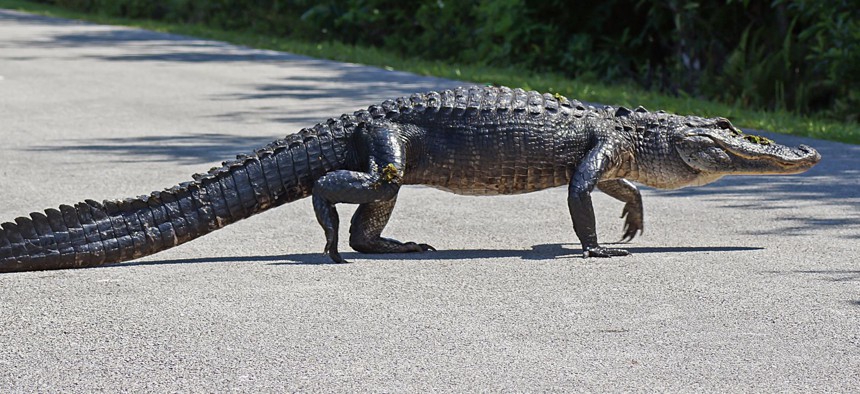By the Numbers: Nuisance Alligator Incidents in Florida

An alligator crosses a bicycle path at Shark Valley in Everglades National Park. Shutterstock
There are an estimated 1.3 million wild alligators in the Sunshine State and it’s the time of year they most mix with people.
This time of year, they trail into the towns of every county in Florida, drawn by the warming springtime sun, seeking sex partners, disrupting the lives of locals and presenting a challenge to state and local authorities tasked with maintaining public safety.
They’re wild and unpredictable. Officials have a name for them: nuisance alligators.
So far this year, according to the Florida Fish and Wildlife Conservation Commission, wranglers have captured and carted away 1,172 of them. Last year, they dragged off 8,050.
This past weekend, an eight-foot alligator jaywalked across busy Commercial Boulevard in Tamarac and was run over by a car.
“He has some broken bones in his back,” reality TV star alligator wrestler Paul Bedard Jr. told the Sun Sentinel. “We’ll probably do some X-rays. We’re going to make sure it’s nothing spinal.”
The Fish and Wildlife Conservation Commission reported last year that unprovoked alligators bit seven people in Florida, one of the victims died as a result. In 2015, unprovoked alligators bit nine people, one fatally. Alligators bit 11 people in 2001, a particularly bad year; three of the bite victims died.
Florida runs five separate programs to manage the rough 1.3 million alligators that live in swamps, near ponds and lakes, along golf course water features and beside swimming pools in all of Florida’s 67 counties.
In addition to alligator education, farming, harvesting and private lands programs, there is the Statewide Nuisance Alligator Program—or SNAP, which employs contract wranglers, like “Gator Boys” star Bedard.
As is the case with threatening animals in other parts of the country—bears, mountain lions, aggressive elk—alligators aren’t fully to blame for violent interactions. The commission’s guidelines make it clear that humans play a role in many of the incidents. They warn residents never to feed alligators, to swim during the day and only in designated areas, and to keep pets close.
“Last May, a Fleming Island family’s beloved dog was attacked by an alligator from a pond near the family’s home,” the Florida Times-Union reported on Monday. “The alligator inflicted a gaping wound resulting in an infection by flesh-eating bacteria.”
The state commission website includes pre-made signs for printing that warn residents against risky behavior. “Create awareness of the possible presence of alligators in ponds and canals…”
“Don’t Feed the Alligators! [It’s] dangerous and illegal,” reads one sign. “Be Alert! Alligators and snakes live in most Florida waterways. Use caution and keep your distance,” reads another.
The alligators that appear below the words on the signs are scaly and spiked. They appear to be digital drawings, like crude video game monsters, their black eyes following you as you read.

John Tomasic is a journalist who lives in Boulder, Colorado.
NEXT STORY: Trump Plans Executive Order to Review Obama’s National Monument Designation





